Star Wars Episode 1 – Darth Maul
Analyse und Reproduktions-Tagebuch
In Arbeit, es fehlt also noch einiges und einiges andere ist noch nicht auf Deutsch übersetzt.
Besucht die Seite öfter, ich update fast täglich, sofern nix dazwischenkommt – und wenn ich update, dann meist „irgendwo in der Mitte der Seite“ (also woran ich grade arbeite)!
Darth Maul scheint auf den ersten Blick ein recht einfaches, schwarzes Kostüm zu sein. Ist es aber nicht. Tatsächlich ist es ziemlich kompliziert – es besteht aus mehreren Lagen – aber der Schlüsselfaktor für ein filmakkurates Darth-Maul-Kostüm sind die Stoffe und Farben – denn weder wurde nur ein einziger Stoff verwendet, noch sind diese Stoffe nur schwarz.
Ich traf ein Mitglied der 501st – Thomas – der mit seinem Darth Maul nicht so glücklich war, welches er von dem „großen asiatischen Kostümhersteller“ (*hust* Costumebase *hust*) bezogen hatte.
Als ich Thomas dann mal beim Troopen traf, wo er das Kostüm trug, wußte ich auch gleich, wieso der nicht so glücklich war.
Die Gesamtform war nicht schlecht (achtung, ich sage nicht, daß die Form richtig war – aber so richtig schlecht halt auch nicht!), aber das Schlimme war, daß das gesamte Kostüm aus demselben Stoff gemacht wurde.
Also: Untertunika, Mitteltunika, Tabard etc. – ALLES derselbe Stoff, und alles gleich schwarz.
Das ist für eine gute Reproduktion dieses Kostümes einfach falsch; und es ist auch weit davon entfernt, screen-akkturat zu sein.
Also stimmte ich zu, ihn mit einem screen-akkuraten Kostüm zu „versorgen“. Diese Seite dient als Analyse des Originals und auch als Dokumentation meiner Arbeit an der Reproduktion.
Ihr wollt jetzt wisse, wieso das Kostüm nicht „einfach nur schwarz“ ist oder komplett aus ein und demselben Stoff gemacht wurde? Na dann lest einfach weiter und folgt meiner Analyse des Kostümes von innen nach außen.
Die Untertunika
Ich fange mit dem an, was dem Körper am nächsten ist – die Untertunika.
Es gibt da ein sehr interessantes Bild, und das ist dies hier:
Wir ignorieren jetzt mal was weiße T-Shirt – das ist ganz offiziell nämlich nicht Teil des Kostümes 😉
Allerdings ist es die schwarze Untertunika, die ebenfalls auf dem Bild getragen wird. Wie man sehen kann, sind die Armlöcher verhältnismäßig klein, während der Seitenschlitz der Tunika fast unverhältnismäßig hoch geht – etwa 10-15cm unter dem Armloch, um genau zu sein (anstelle von „bis zur Taille“, was viele Leute vermuteten).
Was man auch sehen kann, ist, daß die Vorderseite der Tunika mittig geteilt ist (beobachtet, wie sich die Vorderseite auf dem falschen Hoverbike drapiert!), während die Rückseite stattdessen eben nicht geteilt ist.
Da ist aber etwas an diesem Bild, was ich entdeckt habe, als ich in Photoshop mal ein bisserl mit der Beleuchtung herumgespielt habe – und das ist das komische Dreieck auf der Rückseite (links zeigt das Originalbild, rechts habe ich das Dreieck mit roten Linien markiert):
Das ist KEIN Lichteffekt. Wie ihr auf dem Boden sehr gut anhand des geworfenen Schattens sehen könnt, kommt das Licht von oben rechts, also kann sich hinter dem Kopf auf dem Rücken kein „Licht-Dreieck“ befinden.
Thomas, für den ich das Kostüm mache, hatte die Idee, daß das eventuell ein Stuntkostüm sein könnte, bei dem irgendwie ein Harness versteckt wird; aber so was sieht meiner Erfahrung nach anders aus (mit zwei rechteckigen Löchern am Rücken, aber nichts, was einem Dreieck ähneln würde).
Was *ich* vermute, ist, daß das ein dreieckiger bestickter Bereich ist, ähnlich den Linienstickereien am Kragen (zu denen ich gleich noch komme).
Thomas fing dann gleich an, sich die Haare zu raufen und meinte, daß ich das Dreieck vergessen sollte, da man es ja doch nie sieht.
Ich hab allerdings irgendwie immer Probleme, kleine Details zu vergessen, auch wenn man sie nie sieht, wenn das Kostüm komplett angezogen ist… *kicher*…
…und deswegen sieht die obere Rückseite meiner reproduzierten Untertunika jetzt eben so aus (Foto gemacht bei Tageslicht mit Blitz, damit man die Linienstickerei besser sieht – und ja, ich komme auch noch zu der anscheinend falschen Farbe…):
Dieses aufgequiltete Dreieck hat keinen wirklichen Zweck. Es ist nur dekorativ und befriedigt mein Bedürfnis, das hellere Dreieck einfach zu HABEN. Wie ich schon sagte, das hier ist nichts, was man sehen kann, wenn das Kostüm getragen wird, da Darth Maul IMMER die mittlere Tunika über der Untertunika trägt.
Was man im folgenden Ausstellungsbild recht gut sehen kann, ist die Farbe und Struktur des Stoffes, der für die Untertunika benutzt wurde:
Die Farbe ist anthrazit, während die Kragenstickereien etwas heller sind. Auch sieht man an der Kante eine leicht bräunlichere Farbe.
Die Struktur des Stoffes ist ganz klar gewebt, allerdings ist die Webung leicht filzig und meliert. Das ist ein fast hundertprozentiger Bildhinweis darauf, daß es sich hier um einen gewebten Wollstoff handelt, der nach einer Wäsche eben genau diese Art von leicht filziger, melierter Struktur aufweisen würde.
Was die Linienstickereien betrifft, dazu komme ich jetzt. Hier ist ein Ausstellungsbild des Originals…:
Wir ignorieren jetzt mal das (gecrashte) Tabard und den (gröberen) Mantel und konzentrieren und stattdessen auf die Mitte. Was wir dort sehen, sind fünf Linien auf jeder Seite des Kragens; ausgeführt in eher glänzendem (wahrscheinlich Viskose) Garn, die etwa 10cm unterhalb der Kragenöffnung zusammenlaufen. Beachtet, daß an eben diesem Ende die Linien nicht abrupt alle auf derselben Höhe enden, sondern daß es dort Variationen gibt,
Der Kragen ist übrigens ein Schalkragen – nur, daß er nicht runtergeklappt ist. Im Prinzip ist das derselbe Kragen, der auch auf Legolas‘ und Elrond’s Tuniken verwendet wurde – er ist nicht als einzelnes Stück an die Tunika angesetzt, sondern ist „ein Teil“ mit der jeweiligen Vorderseite der Tunika.
Ich werde euch nicht mein Geständnis ersparen, daß ich diesen Kragen zuerst furchtbar falsch gezeichnet hatte, worüber ich allerdings nicht weiter sprechen möchte.
Lasst es mich so ausdrücken; mein furchtbarer Fehler führte dazu, daß ich die Linienstickereien DREIMAL aufgetrennt (und somit VIERMAL NEU gemacht!) und die Naht am Nacken zweimal getrennt habe.
Und erst DANACH (also, zehn Stunden Fluchen später!!!) ist mir endlich aufgefallen, daß ich beim Entwurf des Kragens etwas falsch gemacht hatte, was mich dann endlich zu der Erkenntnis brachte, daß ich BEIDE VORDERSEITEN DER TUNIKA falsch zugeschnitten hatte.
Da mir das GRADE EBEN ERST AUFGEFALLEN IST (und es jetzt 5:23 Uhr morgens ist – ich kann NICHT schlafen, wenn etwas falsch läuft!), und ich dann schnell verifiziert habe, daß noch genug Stoff vorhanden ist, um die vorderen Seiten neu zu schneiden, kann ich jetzt endlich erstmal ins Bett gehen.
Morgen arbeite ich dann an der Tunika weiter, trenne alle Nähte auf, schneide neue Vorderteile zu und mache den Kragen richtig *seufz*
Und entschuldigt, daß ich mich hier mal aufrege. Ich bin nur müde und frustriert, weil ich auf meinen blöden Fehler einen ganzen Tag verloren habe, und meine einzige Entschuldigung ist, daß ich seit etwa 10 Jahren keinen Schalkragen mehr gemacht und deswegen wohl vergessen habe, wie’s geht.
Und SO sollte der Kragen eigentlich aussehen (Foto entstanden, nachdem ich alles neu gemacht hatte…), verglichen mit der Originalfront.
Beachtet bitte, daß die Schneiderpuppe, auf der ich das hier präsentiere, etwa zwei Größen kleiner ist als der Kerl, für den ich das hier anfertige; also soeht’s aus, als wär’s zu groß – isses aber nicht. Die Farbe ist ein bisserl schwer zu fotografieren und sieht daher hier „daneben“ aus:
Was die anscheinend falsche Farbe angeht:
Hier ist ein Vergleichbild zwischen dem Originalstoff der Untertunika und der leichten italienischen Anzugwolle, die ich für die Reproduktion verwende. Ich habe meinen Stoff drinnen mit Blitz fotografiert, denn genau so ist auch das Original fotografiert worden, und um beide vergleichen zu können, mußte ich eben die Lichtverhältnisse nachstellen.
Interessanterweise variiert die Helligkeit ziemlich stark bei dem etwa Dutzend Fotos, die ich gemacht habe – denselben Effekt sieht man bei den Ausstellungsfotos. Für diesen Vergleich habe ich das Bild benutzt, was am hellsten ausfiel. Ich hätte auch jedes andere Foto nehmen können; aber dieses hier zeigt die Webung sehr schön, also habe ich dies ausgesucht.
Ich werdet wahrscheinlich zustimmen, daß die feine italienische Anzugwolle nicht grade die schlechteste Wahl für die Tunika im Bezug auf Farbe und Webart war 😉
Sie ist wirklich sehr leicht und – da Naturfaser – auch sehr luftdurchlässig. Um Thomas zu zitieren (als er den Stoff über den Arm drapiert hatte, um ihn tatsächlich mal zu fühlen): „Ich fühle den kaum!“
Hier ist noch ein Ausstellungbild, was recht klar zeigt, wie das Original vorn schließt:
Die roten Pfeile deuten auf etwas, das entweder Haken/Ösen oder Druckknöpfe sind. Was auch immer es ist, so schließt wahrscheinlich die gesamte Tunika vorne (etwa bis zur Taille).
Was die Länge der Untertunika angeht…
Wie ihr ja schon im ersten Bild sehen konntet (Maul auf dem falschen Bike), geht die Untertunika bis etwa zur Mitte der Wade. Allerdings SITZT er ja auf dem Bild: also ist die tatsächliche Länge noch kürzer.
Hier ist ein Bild, welches die ungefähre Länge im Stehen zeigt.
Wie ihr sehen könnt (und zwar auf dem Knie unter der Hand, die das Lichtschwert hält) ist die Untertunika nur wenig länger als das Knie; ich nenne das „unter-Kniescheibe-lang“.
Die mittlere Tunika (aka „Sith-Robe“)
Over the sleeveless undertunic, Darth Maul is wearing what the 501st calls the ‚Sith Robe‘ in their standards. I prefer to call it the ‚middle tunic‘ (just to clarify the terms I will be using in this analysis).
The fabric used for that middle tunic is interesting. Look at this picture (the shoulder area – what’s close to the neck is the shawl tabbard, to which I will get later):
Now, that is a very nubby fabric with an almost bark-like structure. And actually, I have seen such a structure before. Here’s a picture of a fabric that has a likely structure (ignore the color – the measurement tape is there to indicate the size of that bark-like structure – it’s a centimeter tape; 2.54cm = 1 inch for those of you who need to convert!):
Now, if you were thinking that this is either crinkle cotton or linen, you’re wrong. This photo shows a heavy, loose weave silk noil which was boiled and, in reaction to that, crinkled.
It’s almost impossible to find silk in that weave / weight any more – Aurora Silks has a similar weave, but it’s not exactly the same.
That aside, said picture from the movie shows another very interesting detail. Please click and look at it closely.
See something?
No?
Well the interesting thing is not WHAT you see but what you DON’T see. And that is…
drumroll…
The middle tunic has NO SHOULDER SEAM. Which basically means that the front side pattern piece and part of the upper back are cut as one piece, then joined at the center back.
Actually you can see that upper back part being separated from the lower back part by a seam in this picture – left: original: right: red line indicates the seam. If you look back and forth between the two, you will be able to recognize it in the left picture too (particularly because of the slight gathering / pleating beneath the left side of that seam, caused by gathering of the lower part of the tunic along that seam):
The upper parts of the sleeves are pleated. There are six pleats of which two are ‚facing each other‘, resulting in three deep pleats on each sleeve.
The lower part of the sleeve (the underarm) is also pleated, but those pleats (six around the arm, as far as I could count) are sewn into place. That’s why the lower sleeve is tight while the upper sleeve is bloused.
Here are four pictures to confirm the pleats on the upper and lower arm, indicated by red arrows (as usual – click to enlarge):
The length of the tunic is indicated by a blue arrow in the very last picture – it ends approximately between the knee and mid calf.
There is a vertical pleat at the front of the tunic also. It’s apparently tucked away by the belt; however, not taking chances, I will sew it in place on waist level:
The tabard
I am deliberately not talking about the plural, which would be ‚tabards‘ (and what the Jedi have). Darth Maul is wearing a single tabard, draped around the back of the neck like a shawl – which is why I named it the „shawl tabard“.
If you look at the middle tunic from the backside…
…you will see that you, well, see nothing of the tabard (except a raised, turtle-neck like area around the neck). However, …
…looking at it from the front, the length-wise crinkled shawl tabard becomes very obvious (ignore the red arrows; that’s the same image as the ‚untertunic front closure‘ image from above).
What you can also see in this picture (and very well so!) is the non-crinkled lining of the shawl tabard, which you can clearly see on the edge of the tabard at both sides – it’s slightly more black (and less brownish) than the shawl tabard.
The sunray-pleated coat
Darth Maul’s coat has some very interesting features; besides something that strongly resembles Elizabethan hanging sleeves (I’ll explain that later) it also features full, sewn-in sunray pleating from approximately chest level down.
Let’s start with the fabric first.
The fabric is a really, really coarse linen. Let me show you how coarse that is by using my ‚proportional method‘.
The actor, Ray Park, is said to be 5ft 9in (175 cm) tall (which isn’t exactly tall for a man, but that, too, is something I will get back to later). Let’s have a look at that using a measurement tape.
As you can see, I’ve adjusted the height of this exhibit picture to fit a height of 175cm (1 inch = 2.54cm).
Since that picture is now too blurry to actually see threads, I’ll overlay it with a larger closeup; lining up the head and belt, aided by a lower opacity of the closeup layer.
From there I can zoom in REALLY close, and actually see not just the thread count but also the size of the pleating on top.
The following picture shows two squares, each being 1 inch x 1 inch large.
As you can see, the thread count is approximately 10 threads per inch. That’s 10 threads per 2.54cm, making each thre4ad approximately 2.5mm thick. That IS coarse!
The pleats, on top, are 5 per inch; that’s approximately 0.5cm for each pleat.
However, as I already said, Ray Park is considerably small for a man. Thomas, who I’m reproducing this costume for, is considerably taller. As in: approximately 195cm (6ft 4in) tall.
Now, if the original actor is 175cm tall, that’s 100%. If the person I’m reproducing this for is 195cm tall, that’s ~111.5% compared to Ray Park’s height.
Which means that the thread thickness I need isn’t 2.5mm but closer to 2.8mm. And the pleating on top doesn’t have to be 5mm but almost 5.6mm. The difference MAY seem small, but it’s important to keep in mind to create a screen-accurate reproduction.
I’ve found a considerably coarse and heavy tussah silk, which will work perfect for this reproduction.
The shaping of the hood is interesting too – basically, each pattern piece (the hood is sewn from two pieces which are joined at the center, on top of the head) roughly resembles a half circle. The person I’m making this for compared the shaping to a windsock. Also, unlike the hoods on many Jedi robes, this hood isn’t gathered to fit the neckline.
You can easily see the actual shaping in this pic:
An elongated half-circle with a V-shaped point towards the front collar. Also, in case you doubt it, the following picture shows the seam on top of the hood very well:
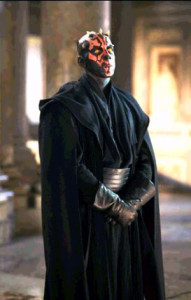
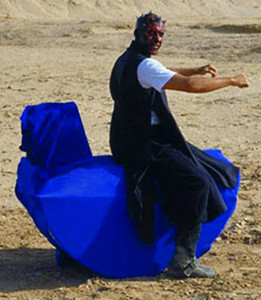
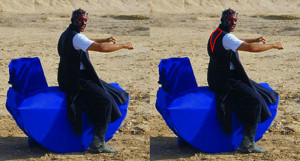

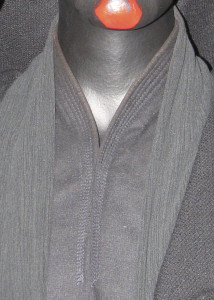
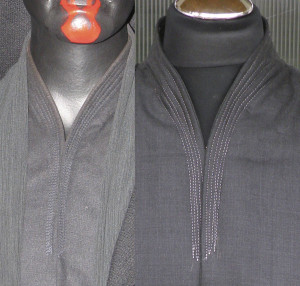
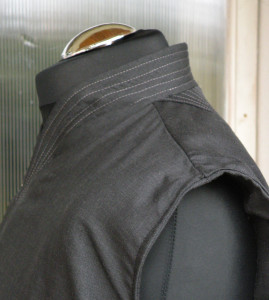
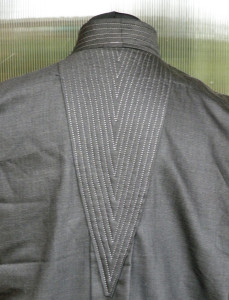
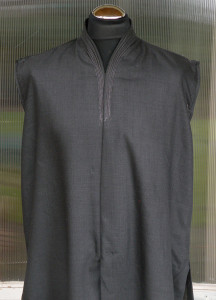
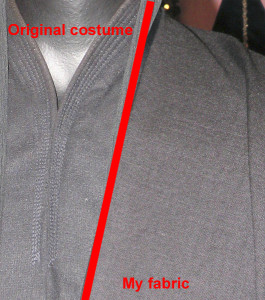
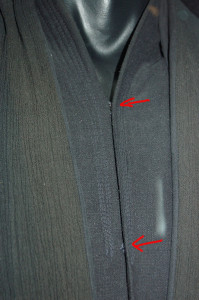
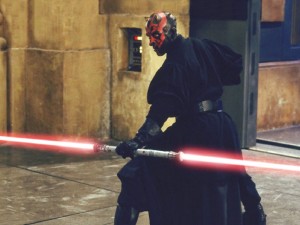
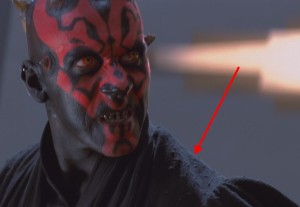
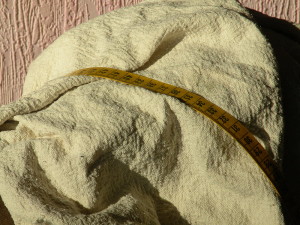
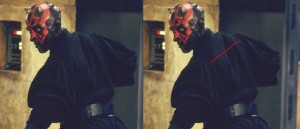
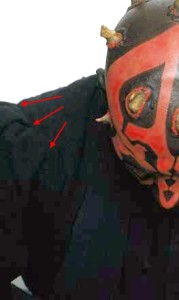
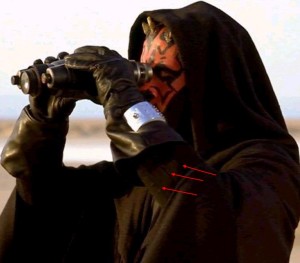
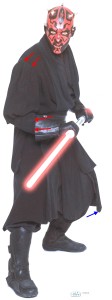
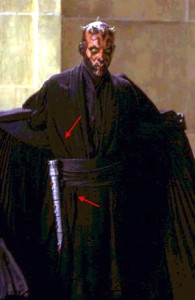
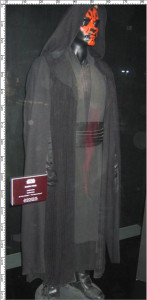
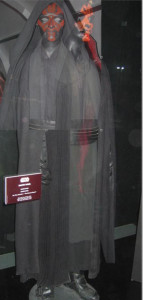
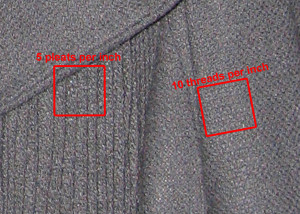
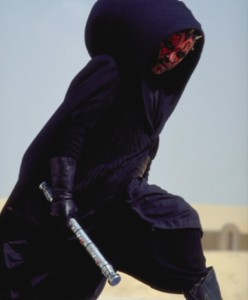

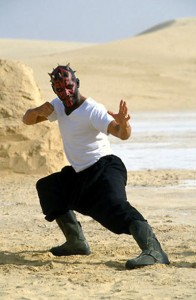
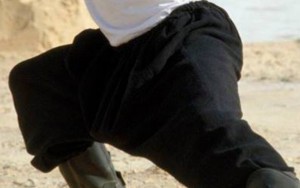
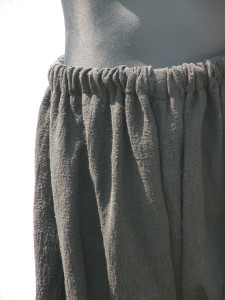
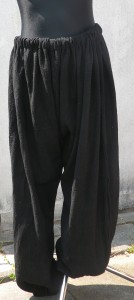
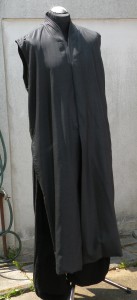
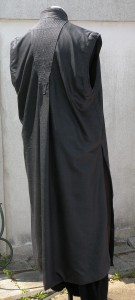
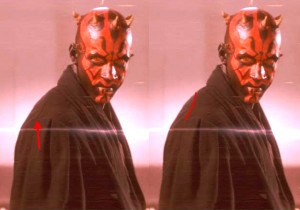
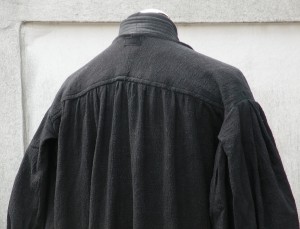
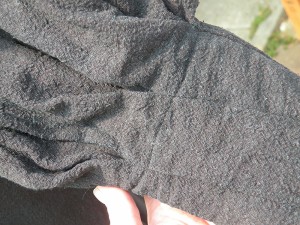
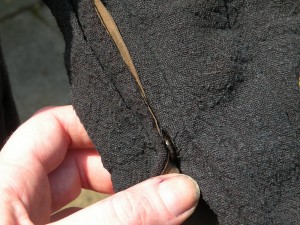
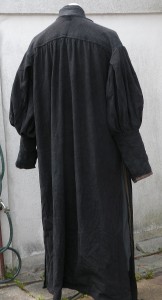
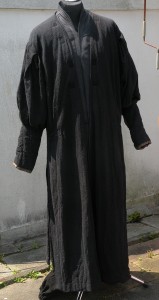
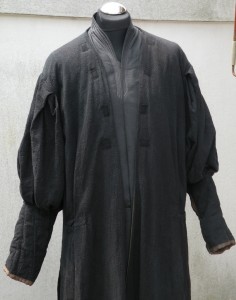
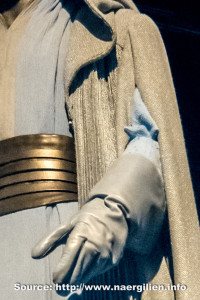
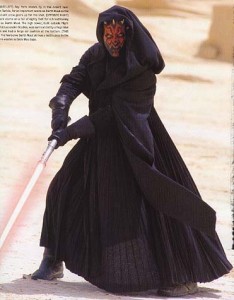
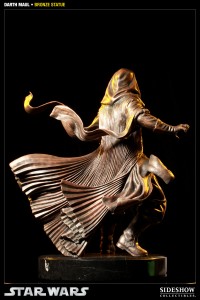
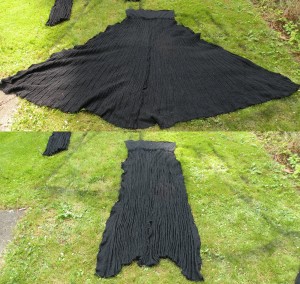
How much would something like this run? I’m very interested in acquiring one of these costumes.
It’s not about money, nor the time. It’s of elegance and grace. I’d ask for a darth maul screen accurate design from you because it’s art. It can be found nowhere else. I suffer from PTSD and my seamstress skills are nullified due to that hindering fact. Please email me to tell me you won’t replicate one more of these outfits, not for a fan. But for someone who used this character to survive years of abuse, and neglect
Very nice attention to detail
Beautiful work and staggering research!
I read other comments saying you wouldn’t be bothered to make the whole costume again,
Could you be swayed to make pieces of it? The undertunic especially I am having an impossible time finding in a screen accurate fashion 😳
Hi would you sell Darth Maul costume and ship international? Like Philippines?
Just fell upon this thread/blog, whatever you call them. LOL. I used to dress up as Darth Maul back when the movie first came out. Shaved head, full make-up, eyes, horns… The costume was just a cheap halloween costume. I have recently become part of the 501st Legion Canadian Garrison (ANH Stunt Stormtrooper) and am considering reprising my role as Darth Maul and become 501st certified. I like the detail you have put into the costume. This is going to help my wife immensely when she makes this costume for me. Nice job!!
Hello. I am looking to have the Darth Maul costume made, and after doing much research into this, your analysis of the costume is the best by far. Would you be willing to make this again for me? Can you send me a rough quote?